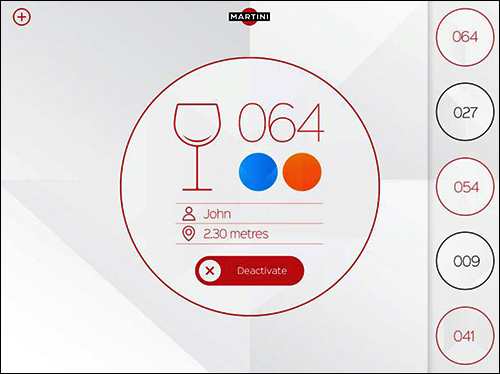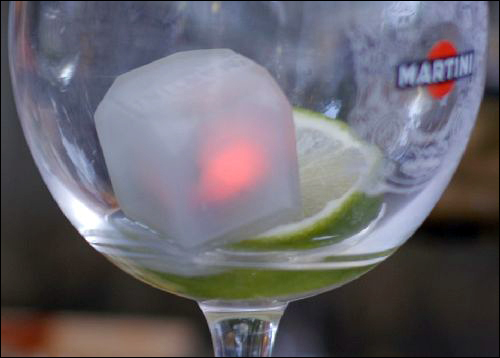When car race fans ordered drinks at last month’s Italian Formula (F1) Grand Prix, at a pop-up bar operated by the Martini wine and spirits company, they could opt for a drink with an intelligent ice cube containing a Bluetooth beacon and sensor that could not only cool their beverage, but also order the next one for them. Martini’s Smart Cube, designed and provided by U.K. creative agency AMV BBDO, detects when a glass is empty and automatically triggers a reorder of that drink, while also enabling bar personnel to quickly locate an individual whose drink requires replacement.
The system has two purposes, says Laila Mignoni, Martini’s creative excellence director: It saves consumers time that they would otherwise have to spend seeking an employee or queuing at the bar to reorder, and it prevents patrons from drinking too much at the bar, since the system is designed to offer only two drinks to each individual.
Martini—commonly known as Martini & Rossi, and one of the world’s largest wine and spirits brands—sells Italian wines, sparkling wines, vermouth and other spirits. The brand began working with AMV BBDO this past spring to develop a technology that would bring greater visibility to the consumption and reordering of drinks at bars. Martini intends to provide the solution to bars once it launches the system at scale within its own temporary bars at Grand Prix races worldwide, or at other sites.
The Smart Cube was first tested earlier this summer at a bar in Rome, on a limited basis, Mignoni says. It was then tested again at the Terrassa Martini Darsena, a pop-up bar at the Grand Prix event held in Monza on Sept. 2-4.
The cube contains built-in capacitive liquid sensors, a Bluetooth Low Energy (BLE) beacon, an antenna, two watch batteries, an on-board processor and LED lights, says James Rowley, AMV BBDO’s director of creative technology. The device transmits data to an iPad, installed at the bar, that is running an app from AMV BBDO.
When a patron orders a drink, the bartender or server asks that individual if she would like to use the Smart Cube system and thereby automatically receive a second drink once she finishes the first. If she agrees, the patron provides her name, which is entered into the app on the bar’s iPad, along with the ID number printed on the Smart Cube. Each cube has a short number printed on it (such as 48) that is linked in the app’s related content-management software on a cloud-based server, with the longer ID number being transmitted by the that cube’s Bluetooth beacon. The patron’s name is then linked with that particular cube in the software.
As the customer takes the drink to her table, the cube detects the amount of liquid in her glass and transmits that information on a regular basis. The app determines the distance from which the signal is received, storing that data (such as 8 meters from the bar) with the cube ID and the patron’s name. One more piece of information is stored with the cube data: Each Smart Cube has a unique color combination in its LED lights—such as blue and green—and that information can then be displayed along with the cube’s ID.
When the patron is close to finishing her drink, the capacitive liquid sensors (one on each side of the cube) detect that the liquid level is dropping and prompt the beacon to temporarily cease transmitting, then begin beaconing again. The beacon is designed this way because an individual may, in some cases, may take the cube out of the drink to look at it, or tilt her glass in such a way that it may seem empty when it is not. By requiring the beacon to wait until it detects an absence of liquid for a minute or more, the system can ensure that drinks are not reordered prematurely.

When the drink is finished, the iBeacon momentarily switches off and back on, which notifies the iPad app that the glass is empty. The tablet’s custom Ice Cube application programming interface (API), written by AMV BBDO, changes the drink’s status to empty and displays an indication to the bartender, who then knows to pour another drink. At the same time, the LED light in the cube begins flashing its unique colors. When a bar employee delivers the drink, he knows the patron’s name, approximately how far from the bar that person’s drink is located (and, thus, the table’s general location) and the cube’s particular light colors. The worker can then quickly bring the drink to the customer and address him by name—for example, “Here’s your drink, Charlie.” This spares the patron the time and effort of having to reorder a drink.
With the system, that second drink could have its own Smart Cube, with an ID number that would be linked to the same patron in the app. During the pilots, however, the second drink was served without a Smart Cube; as such, there would be no automatic reordering option after the second drink was finished.
This ability to prevent a third order, Mignoni explains, ensures that patrons do not over-drink. In fact, she adds, Martini’s corporate policy is to only serve two alcoholic beverages to each patron at its pop-up bars, so such technology helps to prevent the over-serving of any specific customer.
AMV BBDO put in a great deal of effort to ensure that the Smart Cube would work as expected, Rowley says. Because the 2.4 GHz signal transmitted by a Bluetooth beacon can be disrupted by the presence of liquid, the company had to carry out considerable engineering work related to the antenna’s location and orientation within the cube, as well as the type of beacon used and the Smart Cube’s power requirements. The cube contains an aerogel—a porous ultralight solid material derived from a gel—designed by the National Aeronautics and Space Administration (NASA). The aerogel is used to ensure that the Smart Cube functions as an ice cube, by keeping it cool and enabling it to float in liquid.
AMV BBDO opted to incorporate two batteries into the cube rather than just one, in order to ensure that the beacon would receive sufficient power, and designed the cube in such a way that it would raise the antenna above the level of the drink. This was accomplished by designing the shape of the cube, and by using the aerogel to keep the cube buoyant, and the antenna on the top of the cube. Rowley declines to identify the beacon’s manufacturer, or to describe other specific details enabling the cube to transmit well in a busy bar environment. To eliminate the possibility of a drink becoming contaminated, the Smart Cube’s casing is injection-molded using food-safe materials. The contents are then sealed using a food-safe glue.
Martini has numerous bar customers that are interested in deploying the technology, Mignoni reports. But the next step will be to conduct another pilot within its own bar at the F1 Brazilian Grand Prix, being held next month in São Paulo.
The pilot deployments in Rome and Monza, involving hundreds of Smart Cubes, went well, Mignoni says. When patrons were first told about the system and were invited to participate, they had some reservations, she adds, noting that they asked “if we were keeping any information about them.” In fact, the bars only requested a first name, which was not stored when the customer finished her drinks. “They were so happy when they got the next drink” automatically, Mignoni says. As the result, she reports, the system became very popular with patrons.
“Our primary goal is corporate responsibility,” Mignoni says. With the system, she adds, “you can’t serve more than two drinks.” But the secondary benefit is convenience for patrons, who can now spend their time visiting with friends rather than reordering drinks. “At night clubs,” Mignoni states, “particularly with thousands of people each night, it can be hard to get to anyone [to take drink orders].”
Rowley says he continues to work on engineering the Smart Cube, with plans to create a smaller model offering a longer battery life. The existing cube has a battery life of about three to four weeks if it is used regularly, after which the device is discarded. The cube is also designed to go to sleep if it detects no liquid for more than 15 minutes—and this, according to Rowley, can extend the battery life. In addition, he says, AMV BBDO is developing the app to be used by an iPhone, enabling an employee to view reorder information from the beacons anywhere within the bar, and to determine a drink’s location relative to that staff member’s location in the room.



